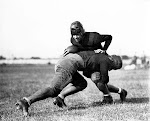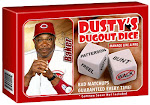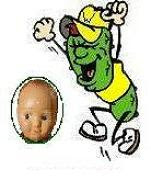
"We don't have an absolutely precise understanding," he says, "of the effect of the airstream on the flight of a baseball with its curious yin-yang pattern of red stitches."
"A baseball curves," he wrote, "as a consequence of asymmetries in the resistance of the air through which it passes. If the air resistance is greater on the third base side than on the first base side of a pitch, the ball will be forced -- curve -- toward first."
When a right-handed pitcher snaps his curve out of the common three-quarter overhand motion, the spins -- broadly clockwise from the pitcher's point of view. Air pressure builds on the third-base side. Pressure diminishes on the first-base side. The ball curves from the third-base side toward first and in the last fifteen feet of flight, as pressures continue to build, it breaks sharply. A factor in the "break" is the baseball's constantly changing speed. Like a bullet, a thrown ball has "muzzle velocity": the speed at which it is traveling when it leaves the pitcher's hand. Coming up against air resistance on its path to home plate, the ball constantly slows.
Adair presents as a laboratory physics model a baseball thrown at seventy miles an hour and rotating from the third-base side toward the first-base side at sixteen hundred revolutions per minute. This approximates a standard curve. By the time the pitch reaches the batter it has slowed to sixty-one miles an hour and is hooking sharply toward first base. Adair calculates that his "standard" curve moves 14.4 inches from a straight path -- about seven inches, more than half a foot, in the last fifteen feet of flight. Thus in the laboratory as on the ball field, a breaking curve ball does exactly what it appears to do. It curves and it breaks.
One uses third-to-first break for reasons of clarity, but the flat, sideways curve is not particularly effective. A slider is flatter and quicker than a curve, leaving the pitcher's hand at eighty miles an hour, or even more. Batters complain, "It looks like a fast ball, until it breaks." The overhand curve -- Carl Erskine, Sandy Koufax, and the young Dwight Gooden threw beauties -- breaks straight down. The rotation on the overhand curve, the spin, runs from heaven to earth. Many believe that the overhand curve is the closest thing there is to a perfect pitch, but it seems to put a fierce strain on the arm. (Both Erskine and Koufax retired early.)
The successful modern major league fast ball ranges between ninety and one hundred miles an hour, although some pitchers with fine control and good ball movement have gotten by with fast balls of eighty-five or even less. Adair calculates that a fast ball gripped across the stitches and thrown at ninety plus miles an hour hops about five inches in the last fifteen feet of flight. The high hard one is not only hard, it hops almost half a foot. How can a baseball move upward against gravity? Another question suggests the answer to that one. How can an airplane fly? The fast ball leaves a pitcher's hand with very strong backspin, and the backspin imparted to the stitches creates lift. Broadly speaking, the stitches are the fast ball's wings. Further models show that sinkers truly sink and that split-finger fast balls drop abruptly.
Tags: Baseball, physics, Robert Adair, Roger Kahn, The Head Game












.jpg)






No comments:
Post a Comment